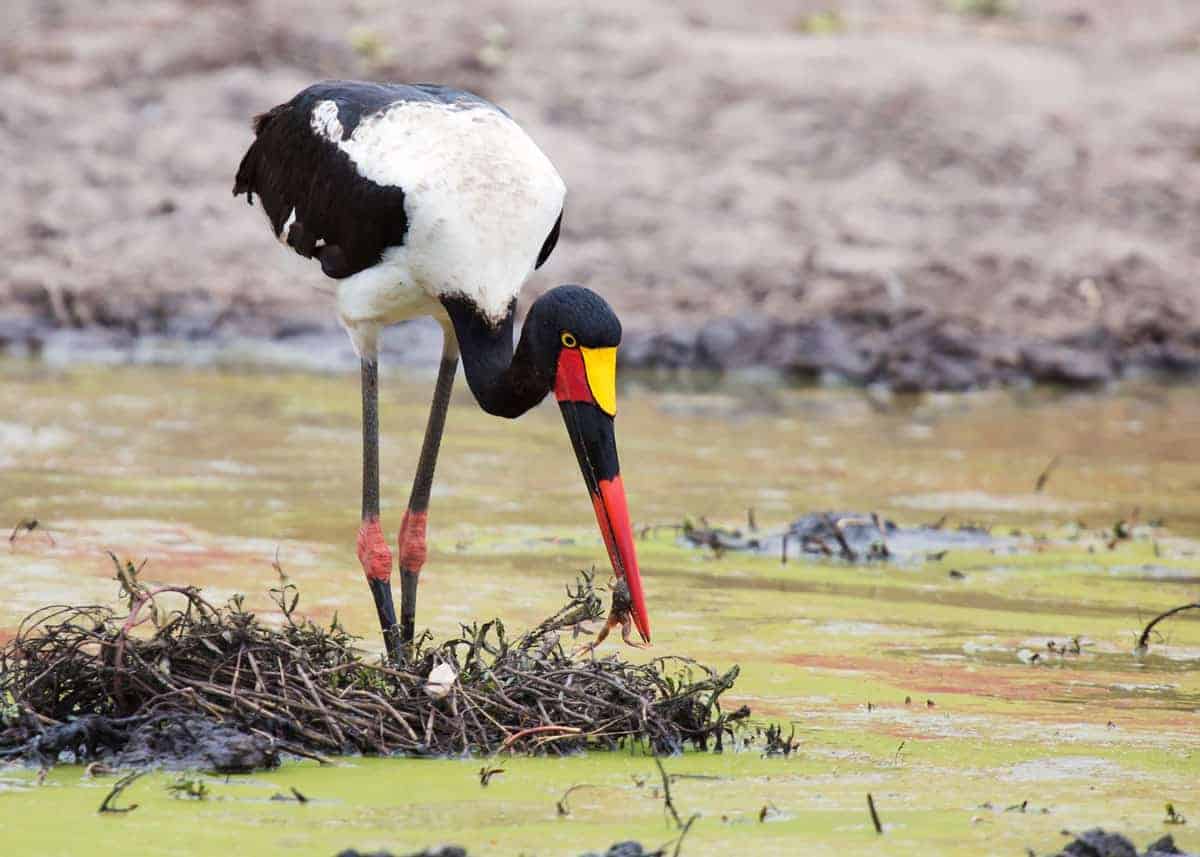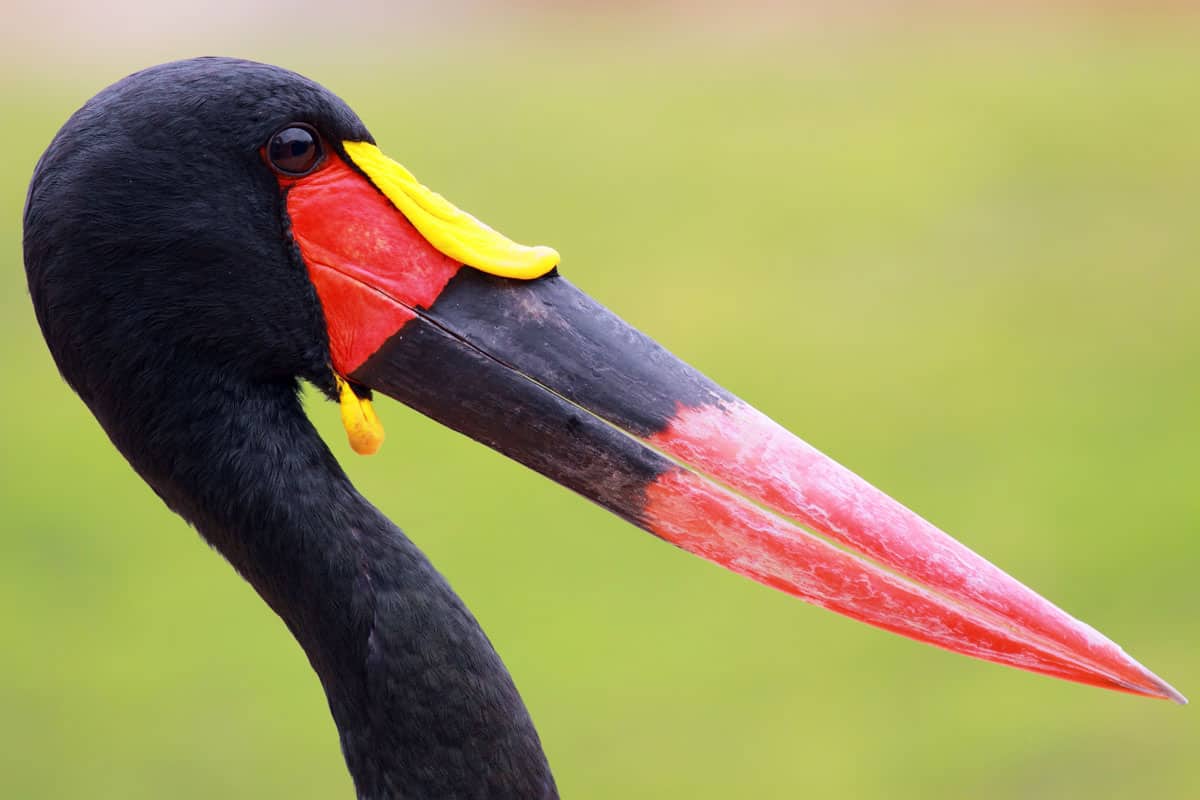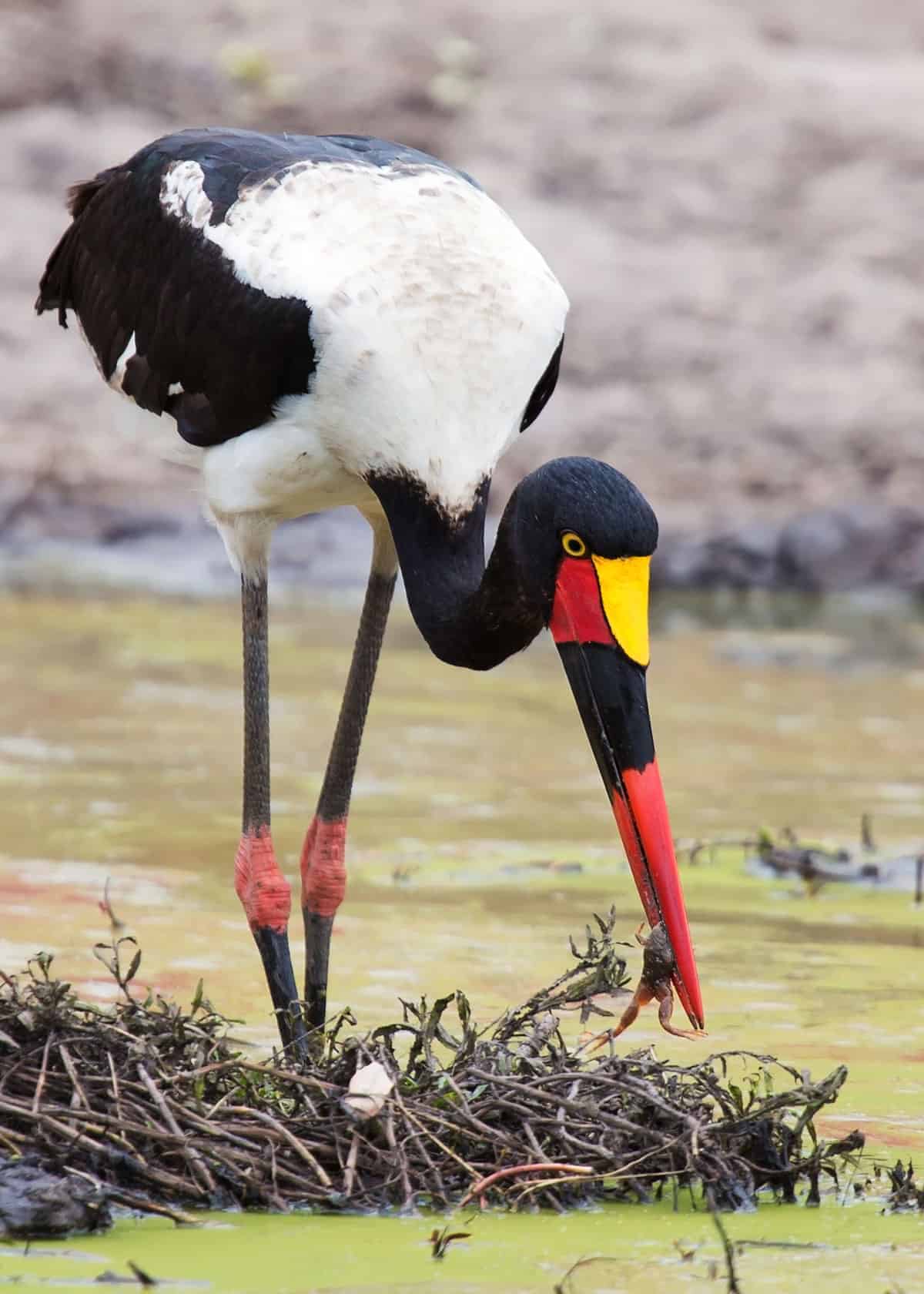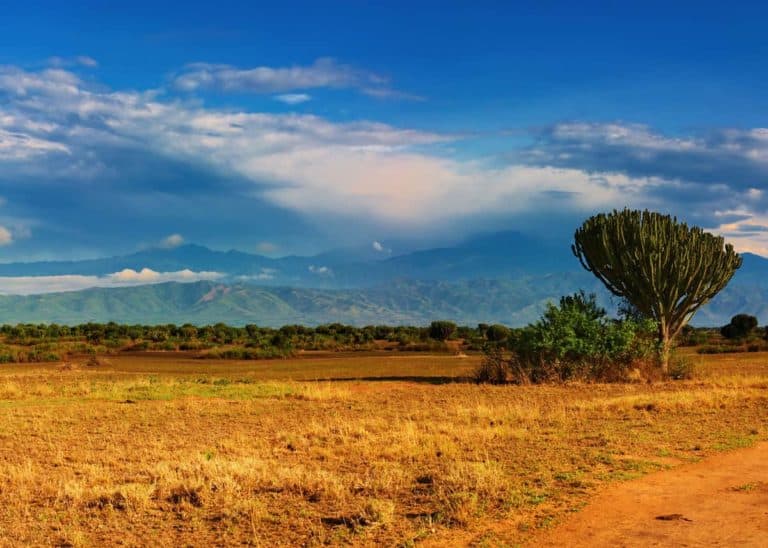15 Facts About Africa’s Saddle-billed Stork (Ephippiorhynchus senegalensis)
The saddle-billed stork is a very tall wading bird found in sub-Saharan Africa. In this post, you’ll learn 15 saddle-billed stork facts, including where it gets its name, differences between males and females, habitat, why they don’t make a call, population, diet, lifespan, tallest bird status, and adaptations.
Learn more about the other birds of Uganda.
15 Facts About Africa’s Saddle-billed Stork
The saddle-billed stork has several noteworthy facts that contribute to the uniqueness of one of the continent’s most beautiful characters. Chances are if you are in Uganda, you will be able to see this fascinating bird for yourself (pictures don’t capture its true brilliance).
Saddle-billed Stork Classification
It’s called the Ephippiorhynchus senegalensis in the scientific world. The saddle-billed stork is classified as follows:
- Phylum: Chordata – This class signifies that it has a spinal column.
- Class: Aves – It belongs to the class of vertebrates comprised of birds.
- Order: Ciconiiformes – It is of the order that are tropical marsh-dwelling, fish-eating, wading birds with long legs and bills that don’t have webbed feet.
- Family: Ciconiidae – It is a member of the stork family described as being large with a long neck, long legs, and is a wading bird with a long, tough beak.
- Genus: Ephippiorhynchus – This is a large black and white colored stork of tropical or semi-arid Africa with a red beak that has a black band around the middle, with red on both sides of the band.
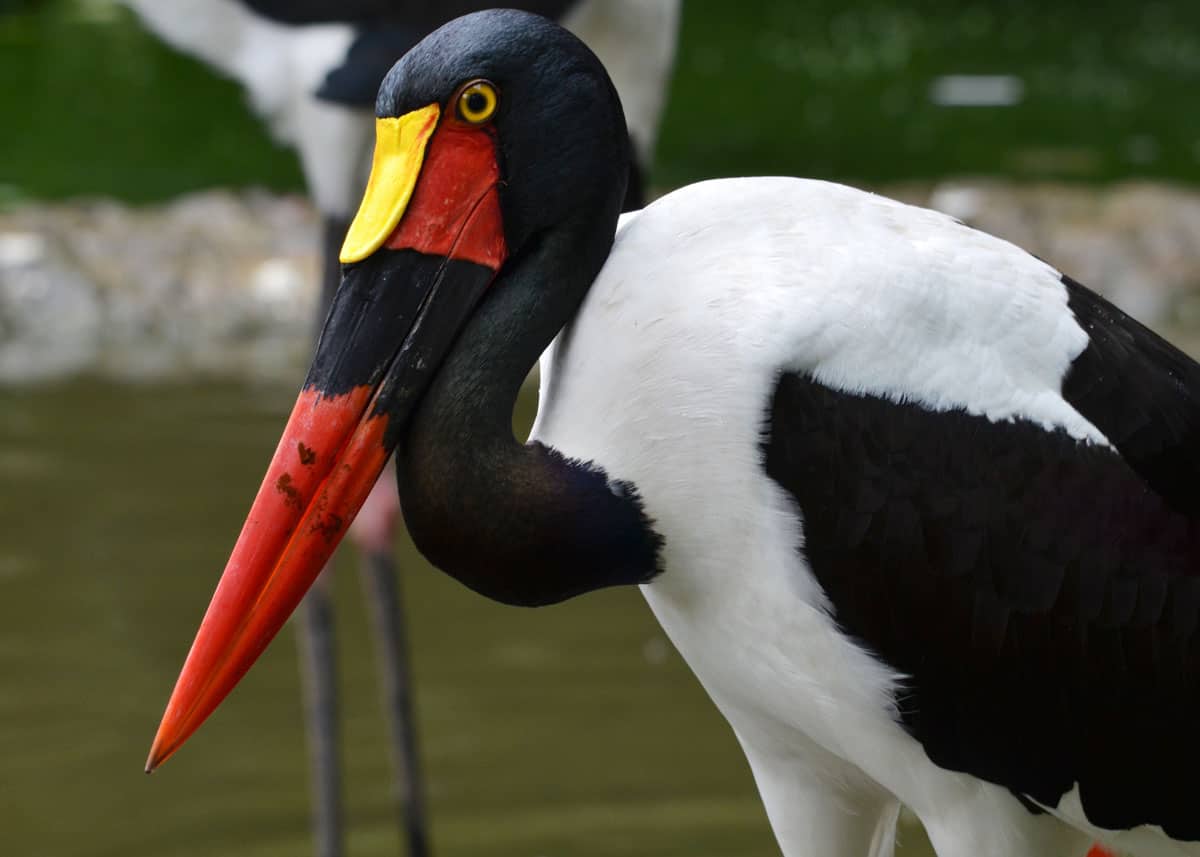
15 Facts About the Saddle-billed Stork
Here are some facts about the saddle-billed stork:
1. It is the Tallest Stork in the World
This is a big bird that grows to a height of 150 cm (59 inches), a length of 142 cm (56 inches) and has a 2.4–2.7 m (7.9– 8.9-foot) wingspan. The male is larger and heavier than the female, weighing anywhere from 5.1–7.52 kg (11.2–16.6 pounds). The female will weigh between 5 and 6.84 kg (11.0 and 15.1 pounds).
This stork’s legs measure 36.5 cm (14.4 inches) long. The beak length can measure 27.3 to 36 cm (10.7 to 14.2 inches) long. Almost five feet tall, this stork is the tallest stork in the world but it is not the heaviest. The heaviest storks are the Jabiru, the Greater Adjutant, and the marabou stork, and they weigh 8 to 9 kg (18 to 20 pounds).
2. Africa’s Bright Colored Bird
The stork’s body is completely white with a featherless red patch of skin in the center of the breast, but the color darkens during the breeding season.
The head, neck, and the tail feathers are also black but have a green iridescence. Primary and secondary flight feathers (the longer and broader feathers on the trailing side of the wing) are white, with black upper and lower covert feathers (smaller, shorter feathers covering the base of the secondary and primary feathers).
The beak is red with a black band going around the middle, and on the upper side is the yellow “saddle” that includes small wattles that hang below the underside of the beak at the base that look like stirrups. The legs are black with red bands around the joints and on their feet.
Learn about other animals in Uganda.
3. Sexual Dimorphism is in the Eyes
Even though the female storks are 10-15% smaller than the males, the way you can tell them apart is that the females have yellow eyes and the males have dark brown eyes.
4. It Has Wide Distribution in Africa Which Includes Uganda
This stork has a wide range covering the central part of the continent, which extends south of the Sahara desert, from Ethiopia and Sudan down to South Africa, which includes several West African countries and Uganda. This amazing bird is at the Sumuliki National Park in Uganda and also north of Murchison Falls and at the Kazinga channel.
5. They Live Where the Water is
The storks live in vast open spaces along the wetlands or swamps and in close proximity to bodies of water so that they have easy access to their preferred food sources. There are sparse trees scattered throughout their natural habitat and sometimes the storks will nest in forests that are close to the water.
6. They Are the Silent Bird
They are silent except for the bill-clacking noise they make at their nests. The saddle-billed stork doesn’t have a syrinx, which is the vocal organ of birds.
The syrinx is the vibrating cavity found in the breasts of many birds which allow them to trill, warble, whistle or sing. Because storks don’t have a syrinx, chicks make hissing sounds when wanting their parents’ attention, but in adulthood they are mute.
7. They Are Shy, Solitary Birds
If this stork isn’t alone, it will be part of a pair, but on rare occasions, they will be in groups of 10 to 12 birds. These storks are solitary nesters. A pair will stay together because they form permanent bonds and are monogamous. They breed in the same nest every breeding period. That is why this species doesn’t have very showy, extravagant courtship displays.
The breeding season starts in the dry season after the rainy season has ended. This stork nests alone in the treetops near water, close to their food sources. The trees they choose, are tall so they are away from threats or disturbances. The storks will reuse the same nest, so they will make repairs by adding new materials to the structure. The nest is built by both adult storks using sticks on the exterior, so it is large with a flat bottom but deep enough for the incubating parent to sit on the eggs. The interior walls of the nest have a plaster of mud, and the lining is a composition of soft materials like reeds and grasses.
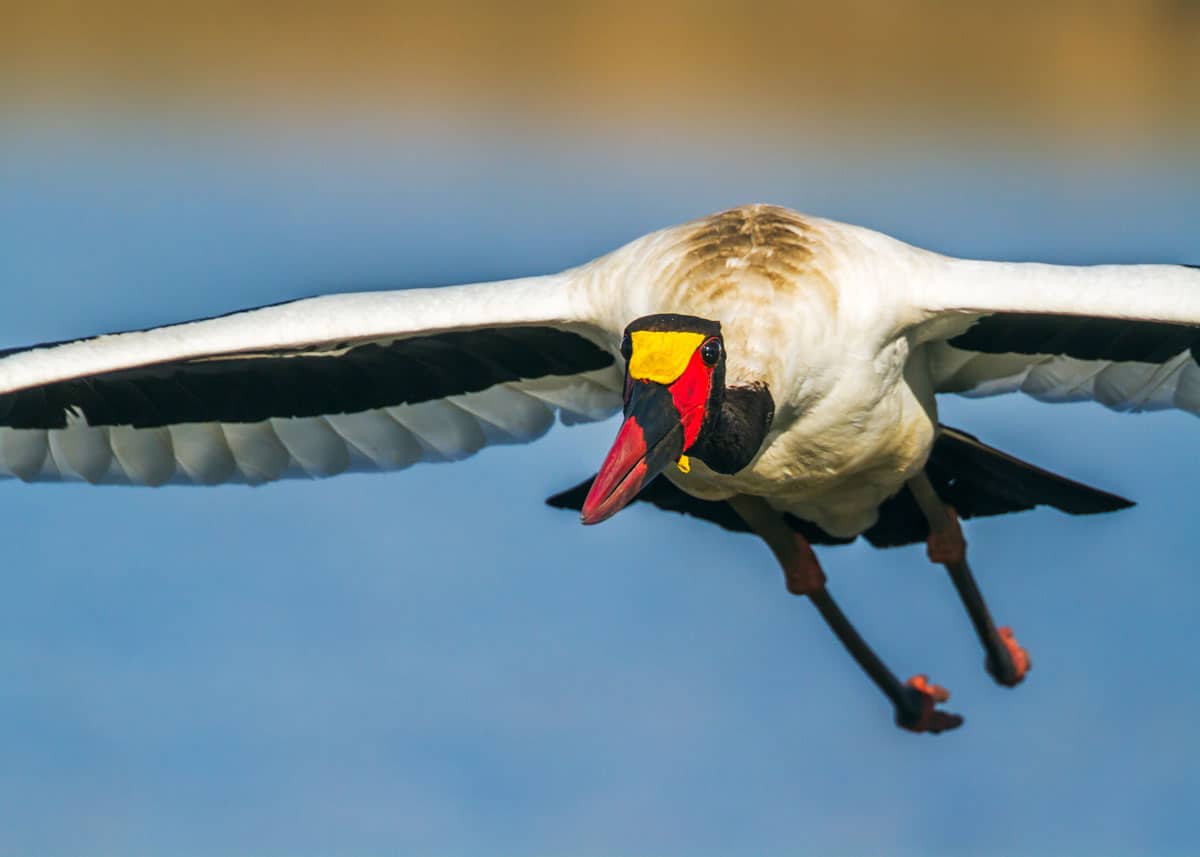
8. Their Kids Stay at Home
The female saddle-billed stork will lay two to three eggs, at every breeding time. The egg weighs approximately 146 grams, and the incubation period can last from 30 to 35 days.
Both parents will sit on the nest to incubate the eggs. When the chicks hatch, they have white, downy feathers, covering their entire body. As they grow older, their white downy feathers give way to a dull grey color before their feathers can become the black and white plumage of the adult storks.
Both parents feed the baby storks for 70 to 100 days after they’ve hatched. This stork species doesn’t breed every year. The juvenile storks will live in close proximity to their parents for one or two years, until the next breeding period.
9. They Have A “Least Concern” Population Status
As of 2016, the population of the saddle-billed stork has a “least concern” status according to the assessment information from The IUCN Red List of Threatened Species. There are 1,000-25,000 storks and of that estimated number 670-17,000 are adult aged storks.
10. Saddle-billed Stork Numbers Are Declining
The saddle-billed stork is widespread in its range. These birds are large enough and nest high enough in the trees, that they are not preyed upon, but their chicks can be. Predators aren’t the cause of their decreasing numbers.
The trend in the population shows that it is declining because of threats to the wetlands. Saddle-billed storks have the status of endangered in South Africa, but they are not as threatened in other countries.
The damage that is being done to the wetlands so that the storks can’t inhabit them is due to excessive use of pesticides, urbanization, and development. They aren’t migratory birds, but they will move if their habitat is no longer habitable to them.
11. They Are Carnivores
The saddle-billed stork has a diet based on fish, crustaceans (crabs, shrimps), and amphibians (frogs). But they will also eat small reptiles (lizards, salamanders), mollusks, bird eggs, small mammals, and large water-beetles. Because the storks will use their beaks to stir up the water to flush out the fish, this causes the water to become muddy as well as the fish so they often wash their fish before consuming them whole.
Watch on YouTube
12. They Live a Long Time in Captivity
In the wild, this stork’s life expectancy is 12 years, but in captivity, they can live for 19 years. The longest recorded lifespan of a captive Saddle-billed Stork is 30 years.
13. Adaptations For Survival In Africa
- Long legs allow the storks to have a high viewpoint, enabling them to see predators over tall reeds and grasses when caring for their fledgling chicks on the ground. Their long legs also allow for wading in deep waters hunting for food.
- The length of the stork’s beak allows them to grab food in deeper water.
- Large wings which contribute to a long wingspan, accommodates their height and weight so they are able to take off effortlessly from the ground.
- Usually, they are non-migratory storks, but they will move if they have to because their habitats are incompatible with them or there is a lack of food.
14. There is Another Species Like the Saddle-billed Stork
Ephippiorhynchus is a small genus of storks that has only two existing species in the group. Both species are almost equal in height and weight with similar wingspans. Both species are black and white in color, with large red and black bills. The sexes of both species have almost identical plumage with the same sexual dimorphism seen in the differing eye color. Other than the Saddle-billed Stork of Sub-Saharan Africa, there is the Ephippiorhynchus asiaticus or the Black-necked Stork which lives in Australia and Asia.
15. The Saddle-billed Stork is Significant in Ancient Egyptian Hieroglyphs
At an archaeological site in Egypt, a rock face was recently discovered to have ancient Egyptian hieroglyphs inscribed in it, which date back 5,500 to 6,000 years ago. In these hieroglyphs, the Saddle-billed Stork is significant to the early Egyptian writing system. This particular bird represents the letters “ba” and the Egyptian Pharaoh, Khaba, used this stork in the hieroglyph depicting his name.
The Saddle-billed Stork had significance in Africa 5,500 to 6,000 years ago and continues to have the same significance today because of its beauty and uniqueness. This bird is an extraordinary sight for you to see.

